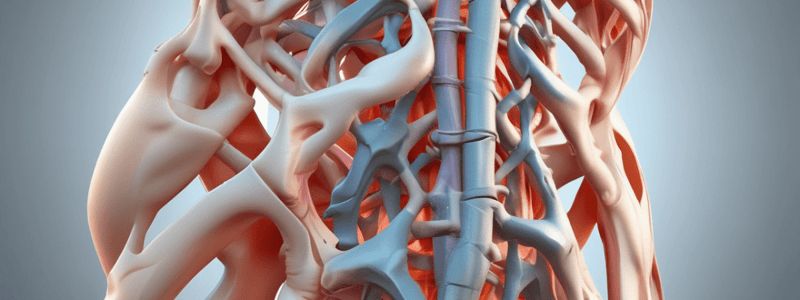Podcast
Questions and Answers
A ruptured or lax ligament can adequately stabilize the associated intervertebral junction.
A ruptured or lax ligament can adequately stabilize the associated intervertebral junction.
False (B)
The function of the Anterior longitudinal ligament includes resisting distraction, translation, and rotation of vertebral bodies.
The function of the Anterior longitudinal ligament includes resisting distraction, translation, and rotation of vertebral bodies.
True (A)
The Ligamentum flavum limits backward flexion, particularly in the lumbar area.
The Ligamentum flavum limits backward flexion, particularly in the lumbar area.
False (B)
The ligament that limits forward flexion and reinforces the posterior portion of the anulus fibrosus is the Posterior atlantoaxial ligament.
The ligament that limits forward flexion and reinforces the posterior portion of the anulus fibrosus is the Posterior atlantoaxial ligament.
The Tectorial membrane is a continuation of the Posterior longitudinal ligament.
The Tectorial membrane is a continuation of the Posterior longitudinal ligament.
The Ligamentum flavum is thickest in the cervical region.
The Ligamentum flavum is thickest in the cervical region.
The Supraspinous ligaments limit backward flexion in the cervical and thoracic regions.
The Supraspinous ligaments limit backward flexion in the cervical and thoracic regions.
The Ligamentum flavum is broad in the lumbar region.
The Ligamentum flavum is broad in the lumbar region.
The Anterior atlantoaxial ligament is a continuation of the Anterior longitudinal ligament.
The Anterior atlantoaxial ligament is a continuation of the Anterior longitudinal ligament.
The cervical region extends from the occipital protuberance to C7.
The cervical region extends from the occipital protuberance to C7.
The ligamentum nuchae limits forward flexion.
The ligamentum nuchae limits forward flexion.
The ilolumbar ligament resists axial rotation.
The ilolumbar ligament resists axial rotation.
The alar ligaments restrict lateral flexion to the same side.
The alar ligaments restrict lateral flexion to the same side.
The intertransverse ligaments limit contralateral lateral flexion.
The intertransverse ligaments limit contralateral lateral flexion.
The apophyseal joint is responsible for absorbing shock and distributing load throughout the vertebral column.
The apophyseal joint is responsible for absorbing shock and distributing load throughout the vertebral column.
Arthrokinematics refers to coupled movements.
Arthrokinematics refers to coupled movements.
Osteokinematics describes the movements within any given intervertebral junction as relatively large.
Osteokinematics describes the movements within any given intervertebral junction as relatively large.
The spinous process and transverse processes provide levers for muscles and ligaments to cause or restrict movement.
The spinous process and transverse processes provide levers for muscles and ligaments to cause or restrict movement.
Axial rotation is defined by the direction of movement of a point on the posterior side of the vertebral body.
Axial rotation is defined by the direction of movement of a point on the posterior side of the vertebral body.
Joint approximation is usually caused by a distraction force.
Joint approximation is usually caused by a distraction force.
Sliding between joint surfaces is caused by a shear force.
Sliding between joint surfaces is caused by a shear force.
Coupled motions are defined as primary movements that consistently accompany a secondary motion.
Coupled motions are defined as primary movements that consistently accompany a secondary motion.
Forward and backward bending are referred to as lateral flexion.
Forward and backward bending are referred to as lateral flexion.
Therapeutic traction involves joint separation (gapping) between joint surfaces.
Therapeutic traction involves joint separation (gapping) between joint surfaces.
Axial rotation between L1 and L2 causes an approximation of the ipsilateral apophyseal joint.
Axial rotation between L1 and L2 causes an approximation of the ipsilateral apophyseal joint.
Sliding (gliding) between joint surfaces involves a linear or curvilinear movement.
Sliding (gliding) between joint surfaces involves a linear or curvilinear movement.
Lateral flexion to the right or left occurs in the sagittal plane.
Lateral flexion to the right or left occurs in the sagittal plane.
Pure lateral flexion and pure rotation can occur in any region of the spine.
Pure lateral flexion and pure rotation can occur in any region of the spine.
Spinal coupling involves movement in two planes that are always perceptible.
Spinal coupling involves movement in two planes that are always perceptible.
Coupling patterns in the cervical spine primarily involve lateral flexion and contralateral axial rotation.
Coupling patterns in the cervical spine primarily involve lateral flexion and contralateral axial rotation.
During primary lateral bending, there is ipsilateral axial rotation in the thoracic spine.
During primary lateral bending, there is ipsilateral axial rotation in the thoracic spine.
The smallest functional unit in the spine includes two adjacent vertebrae and the intervertebral disc only.
The smallest functional unit in the spine includes two adjacent vertebrae and the intervertebral disc only.
In spinal coupling, the automatic movement in one plane is usually imperceptible.
In spinal coupling, the automatic movement in one plane is usually imperceptible.
Coupling movements can be influenced by factors such as muscle action and articular facet alignment.
Coupling movements can be influenced by factors such as muscle action and articular facet alignment.
Primary axial rotation leads to contralateral coupled lateral bending in the lumbar spine.
Primary axial rotation leads to contralateral coupled lateral bending in the lumbar spine.
Geometry of the physiologic curve does not play a role in coupling movements.
Geometry of the physiologic curve does not play a role in coupling movements.
Flashcards are hidden until you start studying




